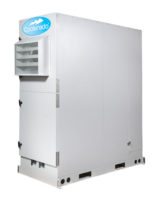The Lossnay cross-flow is key to the system’s ability to improve IEQ. A low-maintenance energy exchange core constructed of a specially treated cellulose fiber membrane prevents the inbound air and exhaust air from mixing while exchanging energy to precondition the air. At the same time, Lossnay ERVs exhaust irritating indoor pollutants such as formaldehyde, pollen, cigarette smoke, dust, and carbon dioxide.
The Lossnay models transfer and exhaust airstreams through adjacent passages in the Lossnay core with minimal cross contamination. In cold months with low humidity, inbound air is warmed and humidified with the warmer indoor air; in warm months, air is cooled and dehumidified with the cooler exhausted air. This minimizes the load on the cooling and heating system. Humidity control is enhanced because the ERV’s core incorporates heat transmission plates specially treated to allow water vapor molecules to pass through and to help equalize the indoor humidity levels.
Within the LGH-F-RX3 series, there are four available ERV models offering CFM levels from 300 to 1,200 and two remote controllers – one for use with Mitsubishi Electric’s M-NET controls network and one for independent control. Lossnay ERVs are compatible with TG-2000 software, LMAP LonWorks® device and BACnet, further increasing the scope of total system management. Additionally, each Lossnay ERV unit comes standard with the M-NET adapter, so networking systems connected with CITY MULTI VRFZ systems has never been easier.

